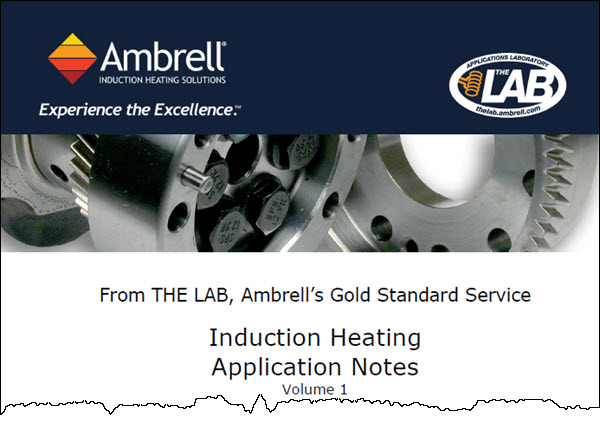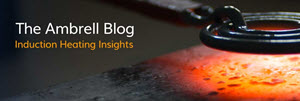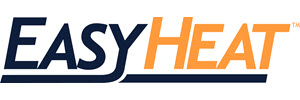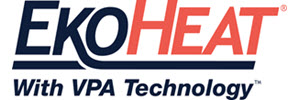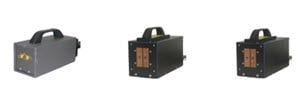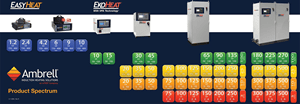How does carbide heating with induction work?
Improve your carbide heating process without a flame. Make the process of tipping and brazing carbide inserts efficient and safe with induction heating.
Induction generates an electromagnetic field in a work coil that induces currents in the conductive material of a workpiece placed within or near the coil. Friction from these currents elevates the temperature of the workpieces and filler to be brazed.
Benefits of Induction for Carbide Heating
Carbide tipping is a process for brazing a harder tip material to the body of a steel cutting blade, resulting in a tool that can last much longer and cut faster than steel alone.
Induction heating is ideal for this process since it focuses the energy on the carbide and the braze area in a flameless process without heating the entire tool.
Select from our collection of carbide-tipping notes, taken from years supporting our customers. Read how we helped to solve their process heating challenges.
 Heating Steel Cutting Tools for Carbide Removal
Heating Steel Cutting Tools for Carbide Removal
Using induction to heat magnetic steel cutting tools for removal of carbide cutting tips. Induction efficiently and precisely heats the client's part in a controlled manner delivering only the required heat.
 Brazing, De-brazing Carbide, Steel Plates
Brazing, De-brazing Carbide, Steel Plates
A custom-designed special multiple-turn helical coil was built to generate the required heating to heat a carbide and steel plate assembly for a brazing and de-brazing application in the oil and gas industry.
 Brazing a Carbide Tip and Magnetic Steel Tube
Brazing a Carbide Tip and Magnetic Steel Tube
To braze carbide inserts into magnetic steel tubes, an inconsistent torch process was replaced with induction brazing equipment. In this application, quality rather than speed was the top priority.b
 Brazing a Steel and Carbide Assembly
Brazing a Steel and Carbide Assembly
To braze a steel and carbide assembly to create a mining bit for the oil and gas industry, this client replaced their torch process with the repeatable and flameless induction brazing technique.
 Brazing, De-Brazing Diamond Carbide Inserts
Brazing, De-Brazing Diamond Carbide Inserts
Heat steel cutting bits with diamond-carbide inserts for brazing and de-brazing; the end products are cutting tools
 Brazing a steel and carbide dental assembly
Brazing a steel and carbide dental assembly
This configuratoin achieved the client's objective. The channel coil - specially designed by THE LAB at Ambrell- was critical to the application's success.
 Copper block & carbide; contact assembly
Copper block & carbide; contact assembly
Induction completed the carbide brazing process more rapidly than an oven, delivering heat exactly where it's needed, operating instant on/instant off
 Brazing a steel coupler and a steel wire
Brazing a steel coupler and a steel wire
Induction heating enabled the brazing process to be completed within 30 seconds. The client was using a torch, and induction offers superior repeatability with no open flame and delivering heat only where it's required...
 Brazing brass tube and fitting assemblies
Brazing brass tube and fitting assemblies
The brass tubes and fittings heated to required temperature far more quickly than with customer's torch method, resulting in improved part quality and introducing less heat into the production environment...
 Brazing carbide tips to a steel cutter
Brazing carbide tips to a steel cutter
The cutter was held in a vice and the coil was presented to heat the assembly. A ceramic rod was used to press the carbide tip onto steel cutter during brazing.
 Brazing a carbide ball to a spring to create a part that controls the armature position in a motor
Brazing a carbide ball to a spring to create a part that controls the armature position in a motor
To heat a tungsten carbide ball and steel rod that acts as a spring to 1300 °F (704 °C) within five seconds for a brazing application to create a part that governs the armature position in a motor...
 Heat a steel block with a cutout for carbide for a brazing application
Heat a steel block with a cutout for carbide for a brazing application
Induction delivers improved quality and repeatability; client was using a torch and induction offered more precise, repeatable heating. In addition, this allowed the client to achieve the targeted heating time of 60 seconds, faster than what the torch could deliver...
 Brazing carbide insert to steel pipe gripper chuck
Brazing carbide insert to steel pipe gripper chuck
Induction heating is proposed to braze carbide inserts into steel blocks in the assembly of pipe gripper chuck. To replace a hand/flame process, delivering significant reduction in per-part cycles...
 Brazing a stainless steel shaft to a carbide for a digger used in mining
Brazing a stainless steel shaft to a carbide for a digger used in mining
A three turn helical coil is used to braze the carbide to the shaft. The steel shaft is fluxed and the braze shim placed on top. The carbide tip is fluxed and placed on top of the shim, lining up the countersunk hole in the carbide. The hole is not fluxed because the flux outgases and causes the carbide to build up pressure and attempt to repel from the shaft...
 Brazing a stainless steel shaft to a carbide cone for a gripper
Brazing a stainless steel shaft to a carbide cone for a gripper
A three-turn helical coil is used to braze the carbide to the stainless steel shaft. A silver solder washer is placed over the post on the shaft, the carbide is placed on the washer and flux is applied...
 Braze a carbide tip to steel cutting tool
Braze a carbide tip to steel cutting tool
A split helical coil is used to heat the carbide & circular steel cutter evenly for the brazing application. The circular steel cutter is placed in a vise and the carbide and braze shim are placed onto the tooth...
 Braze a diamond carbide tip onto band saw blade
Braze a diamond carbide tip onto band saw blade
A single turn helical coil is used for this brazing process. The saw blade and diamond carbide tip are placed in the coil...
 Brazing carbide teeth to steel pipe jaw section
Brazing carbide teeth to steel pipe jaw section
Induction heating provides hands-free heating that involves no operator skill for manufacturing, consistent, repeatable aesthetically pleasing brazes with even distribution of heating
 Heating Hammer Bits for Shrink Fitting
Heating Hammer Bits for Shrink Fitting
Shrink-fitting hammer bits with induction for the insertion of carbide buttons; the end product is a drilling tool for the oil and gas industry.
 Brazing a carbide and steel shank for a plug guage
Brazing a carbide and steel shank for a plug guage
Induction heating provides hands-free brazing which requires no special operator skills for manufacturing, precise, even heat is applied and is divided equally, between the shank and the carbide, providing an even flow of the braze alloy as the parts reach brazing temperatures.
 Steel-carbide brazing cutting tool
Steel-carbide brazing cutting tool
The body shim and carbide are cleaned and braze flux as applied to the entire surface of the assembly. The parts are placed together in the induction coil.
 Brazing carbide to steel for a surgical device
Brazing carbide to steel for a surgical device
Compared to a stick-fed flame braze heating, induction heating provides consistently higher quality joints. This is critical for medical applications.
 Brazing Carbide Tips to a Meat Cutter
Brazing Carbide Tips to a Meat Cutter
Due to the size of the induction coil, the process allows for precise placement of the carbides on the steel shanks
 Brazing carbide rotary file to high speed steel shanks
Brazing carbide rotary file to high speed steel shanks
A multi-turn helical coil is used. The part is heated to determine the time required to reach the desired temperature and required heat pattern. I
 shrink-fitting a carbide ring into a valve seat
shrink-fitting a carbide ring into a valve seat
A three turn helical coil is used to heat the steel valve seat. The steel valve seat is placed in the coil and heated for 50 seconds to enlarge the center hole & drop the carbide ring in for the shrink-fitting process.
Induction heating delivers reduced ring warping compared to furnace heating and decreased cycle time due to reduced ramp-up and cooldown times
 Brazing Carbide Tips on Drill Bits
Brazing Carbide Tips on Drill Bits
A brazing temperature of 1900°F was reached through the use of a unique 4 turn helical coil. D
Can Silicon Carbide be Heated by Induction?
Yes, silicon carbide can be heated by induction. Induction heating is a process that uses a rapidly changing magnetic field to induce an electric current in a conductive material. This current then generates heat, which can be used to heat the material. Silicon carbide is a semiconductor, which means that it has some conductivity. This makes it possible to heat silicon carbide by induction.
Induction Coil Silicon Carbide or Graphite?
The choice of material for an induction coil crucible depends on the type of metal being melted and the desired melting temperature. Silicon carbide (SiC) and graphite are the two most common materials used for induction coil crucibles.
SiC crucibles are more expensive than graphite crucibles, but they are also more durable and have a higher melting point. SiC crucibles are also less likely to contaminate the metal being melted. However, SiC crucibles can be brittle and can shatter if they are not handled carefully.
Can Carbide Heating be used for Boron?
Yes, carbide heating can be used for boron. Boron carbide is a very hard material that is used in a variety of applications, including cutting tools, armor, and abrasives. It is made by reacting boron oxide with carbon at high temperatures. Carbide heating can be used to heat boron carbide to the high temperatures required for these applications.
From our blog
Other carbide-tipping Resources
Four Ways To Contact Ambrell for Support
AMBRELL CORPORATION
1655 Lyell Avenue
Rochester, NY 14606
United States
F: +1 585 889 4030
AMBRELL B.V.
Holtersweg 1
7556 BS Hengelo
The Netherlands
AMBRELL Ltd.
Unit 6, Space Business Centre
Tewkesbury Road
Cheltenham, GLOS, GL51 9FL
United Kingdom
F: +31 546 788 154


 Brazing Diamond Drill Inserts
Brazing Diamond Drill Inserts